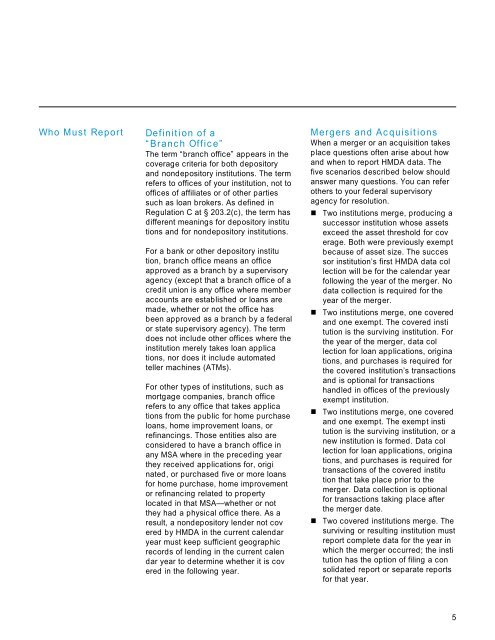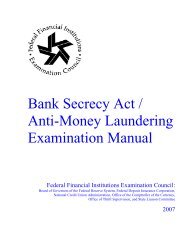A Guide to HMDA Reporting - ffiec
A Guide to HMDA Reporting - ffiec
A Guide to HMDA Reporting - ffiec
You also want an ePaper? Increase the reach of your titles
YUMPU automatically turns print PDFs into web optimized ePapers that Google loves.
Who Must Report Definition of a<br />
“Branch Office”<br />
The term “branch office” appears in the<br />
coverage criteria for both deposi<strong>to</strong>ry<br />
and nondeposi<strong>to</strong>ry institutions. The term<br />
refers <strong>to</strong> offices of your institution, not <strong>to</strong><br />
offices of affiliates or of other parties<br />
such as loan brokers. As defined in<br />
Regulation C at § 203.2(c), the term has<br />
different meanings for deposi<strong>to</strong>ry institutions<br />
and for nondeposi<strong>to</strong>ry institutions.<br />
For a bank or other deposi<strong>to</strong>ry institution,<br />
branch office means an office<br />
approved as a branch by a supervisory<br />
agency (except that a branch office of a<br />
credit union is any office where member<br />
accounts are established or loans are<br />
made, whether or not the office has<br />
been approved as a branch by a federal<br />
or state supervisory agency). The term<br />
does not include other offices where the<br />
institution merely takes loan applications,<br />
nor does it include au<strong>to</strong>mated<br />
teller machines (ATMs).<br />
For other types of institutions, such as<br />
mortgage companies, branch office<br />
refers <strong>to</strong> any office that takes applications<br />
from the public for home purchase<br />
loans, home improvement loans, or<br />
refinancings. Those entities also are<br />
considered <strong>to</strong> have a branch office in<br />
any MSA where in the preceding year<br />
they received applications for, originated,<br />
or purchased five or more loans<br />
for home purchase, home improvement<br />
or refinancing related <strong>to</strong> property<br />
located in that MSA—whether or not<br />
they had a physical office there. As a<br />
result, a nondeposi<strong>to</strong>ry lender not covered<br />
by <strong>HMDA</strong> in the current calendar<br />
year must keep sufficient geographic<br />
records of lending in the current calendar<br />
year <strong>to</strong> determine whether it is covered<br />
in the following year.<br />
Mergers and Acquisitions<br />
When a merger or an acquisition takes<br />
place questions often arise about how<br />
and when <strong>to</strong> report <strong>HMDA</strong> data. The<br />
five scenarios described below should<br />
answer many questions. You can refer<br />
others <strong>to</strong> your federal supervisory<br />
agency for resolution.<br />
¢ Two institutions merge, producing a<br />
successor institution whose assets<br />
exceed the asset threshold for coverage.<br />
Both were previously exempt<br />
because of asset size. The successor<br />
institution’s first <strong>HMDA</strong> data collection<br />
will be for the calendar year<br />
following the year of the merger. No<br />
data collection is required for the<br />
year of the merger.<br />
¢ Two institutions merge, one covered<br />
and one exempt. The covered institution<br />
is the surviving institution. For<br />
the year of the merger, data collection<br />
for loan applications, originations,<br />
and purchases is required for<br />
the covered institution’s transactions<br />
and is optional for transactions<br />
handled in offices of the previously<br />
exempt institution.<br />
¢ Two institutions merge, one covered<br />
and one exempt. The exempt institution<br />
is the surviving institution, or a<br />
new institution is formed. Data collection<br />
for loan applications, originations,<br />
and purchases is required for<br />
transactions of the covered institution<br />
that take place prior <strong>to</strong> the<br />
merger. Data collection is optional<br />
for transactions taking place after<br />
the merger date.<br />
¢ Two covered institutions merge. The<br />
surviving or resulting institution must<br />
report complete data for the year in<br />
which the merger occurred; the institution<br />
has the option of filing a consolidated<br />
report or separate reports<br />
for that year.<br />
5
















